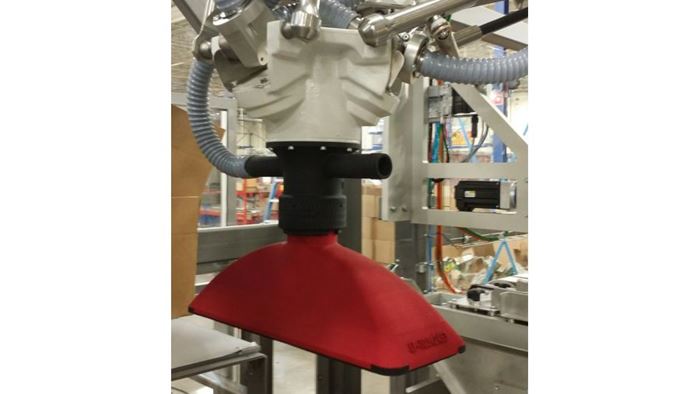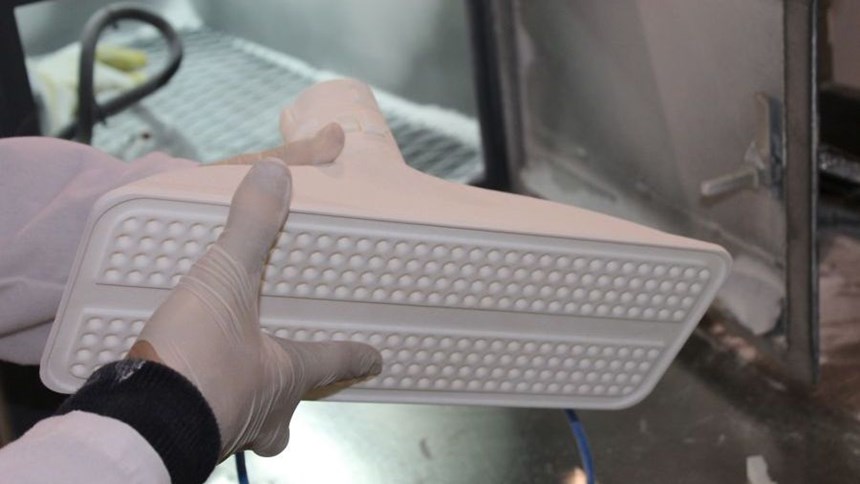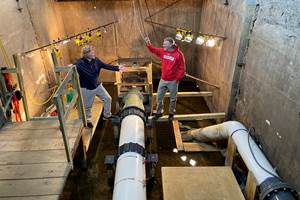Laser-Sintered Grippers Solve Robotic Packing Challenges
Additive manufacturing produced lighter, stronger vacuum grippers for robots on a food packaging line.
Share
Read Next
New robots for the customer’s pick-n-pack line were already on order when Langen Group, equipment supplier to the major U.S. food producer, began designing the end-of-arm tooling that would enable the robots to pick up wrapped, stacked crackers and place them into cardboard boxes. The engineers soon discovered a challenge: To maximize speed without upsetting the robots’ center of gravity, the combined weight of the tool and the product could be no more than 2 kilograms. Because the largest load of crackers was a 10-pack weighing 1.5 kilograms, end-of-arm tooling could weigh no more than 500 grams.
Langen turned to Anubis 3D, a division of Anubis Manufacturing Consultants Corp., for support. Using laser sintering technology from EOS, Anubis was able to design and manufacture end-of-arm tooling that fit within the weight restrictions for the robots and performed with better gripping force than legacy grippers.
Anubis is an engineering and design consultancy firm based in Mississauga, Ontario, founded by Tharwat Fouad in 2005. Its main markets include the food and beverage, chemical, powder handling, and plastics manufacturing industries. The Anubis 3D division specializes in low-volume additive manufacturing (AM) of parts that are either too expensive, too complex or outright impossible to make through conventional manufacturing techniques.
The division currently owns three additive manufacturing machines from EOS, including an EOSINT P 395. This powder-bed laser sintering system uses a 50-watt CO2 laser to quickly and accurate “grow” parts from thermoplastic. The machine can build parts measuring as large as 340 by 340 by 620 mm with layer thicknesses ranging from 0.06 to 0.18 mm.
Since establishing this division, Anubis has designed a number of laser-sintered tools for injection molding and bottle packaging customers, as well as various brackets and supports. When Langen came to Anubis with the robot tooling challenge, Fouad knew that additive manufacturing could provide a solution.
In addition to weighing less than half a kilogram, the robot grippers for the pick-and-pack line had to be able to handle multiple package shapes and sizes. The food producer wanted a single tool that could handle three boxes sizes in two different configurations. The tool also needed to be quick-release and quick-connect so operators could change from one size to another without bolts and nuts that would add assembly time.
“Meeting these requirements would have been impossible with aluminum and sheet metal,” says Fouad. “To handle a heavier metal tool they’d have to reorder larger robots, which would have been more expensive—and they were also under extreme time constraints.”
Instead of a more traditional metal vacuum plate and shroud, Anubis created a lighter, streamlined set of components to be made on its EOSINT P 395 machine. The parts were designed specifically for AM using SolidThinking's Inspire software to optimize the design of the structures organically, following the lines of the geometry and adjusting the thickness as needed for strength and/or flexibility. Finite Element Analysis (FEA) is built into the optimization to analyze stresses and strains on the structure.
The material used for the main vacuum part was nylon 12 (PA 2200 material from EOS), chosen for its flexibility and ability to sustain crash loads, and because it is certified as USP Class VI approved for food contact. Anubis loaded the material properties and vacuum requirements into the software, then used those calculations to determine how many and what size holes should be placed in the vacuum cup.
“The options we looked at were whether to have fewer but larger holes, or more, smaller ones,” says Fouad. First the Anubis team duplicated the traditional aluminum plate hole layout using nylon 12 in the EOSINT P 395 system and tested the gripping power of the result. Then, to further increase the grip, they created a new design with profiled holes and channels that could not have been manufactured conventionally.
The team found that the second design, with a larger number of smaller holes laid out in a Swiss cheese pattern of channels leading to the primary vacuum hole at the top of the workpiece, created a superior grip on the cracker stacks, providing four times the gripping force of legacy vacuum grippers. Compared to similar machined designs, the laser-sintered version uses less air but has greater picking power.
“The efficiency of the new hole profile we developed with EOS technology enabled the redesigned gripper to suction so well you could actually hang on it with your own weight,” says Fouad.
In contrast to a more traditional vacuum plate and shroud, which would have taken months to design and manufacture, Anubis took only a week to additively manufacture, assemble and test the new lightweight tool. After a light bead blasting, the laser-sintered parts were dyed per customer specifications and assembled with the mounting pieces. The vacuum grippers were delivered to Langen Group and installed on the newly arrived robots at the food producer’s plant.
“To design and produce tooling capable of picking what we wanted while still staying within the payload constraints of the robot would have been impossible before,” says Robert Husnik, Langen Group engineering manager. “Due to the freedom provided by plastics laser-sintering, we can now do the impossible.”
Related Content
What Does Additive Manufacturing Readiness Look Like?
The promise of distributed manufacturing is alluring, but to get there AM first needs to master scale production. GKN Additive’s Michigan facility illustrates what the journey might look like.
Read MoreDrones Take Flight with Metal and Polymer 3D Printed Parts: The Cool Parts Show Bonus
Drones produced by Cobra Aero now incorporate many 3D printed parts made through laser powder bed fusion and Multi Jet Fusion processes.
Read More8 Cool Parts From RAPID+TCT 2022: The Cool Parts Show #46
AM parts for applications from automotive to aircraft to furniture, in materials including ceramic, foam, metal and copper-coated polymer.
Read MoreHow Large-Format 3D Printing Supports Micro-Scale Hydropower
There is potential hydroelectric power that has never been unlocked because of the difficulty in capturing it. At Cadens, additive manufacturing is the key to customizing micro-scale water turbine systems to generate electricity from smaller dams and waterways.
Read MoreRead Next
At General Atomics, Do Unmanned Aerial Systems Reveal the Future of Aircraft Manufacturing?
The maker of the Predator and SkyGuardian remote aircraft can implement additive manufacturing more rapidly and widely than the makers of other types of planes. The role of 3D printing in current and future UAS components hints at how far AM can go to save cost and time in aircraft production and design.
Read MoreHybrid Additive Manufacturing Machine Tools Continue to Make Gains (Includes Video)
The hybrid machine tool is an idea that continues to advance. Two important developments of recent years expand the possibilities for this platform.
Read More4 Ways the Education and Training Challenge Is Different for Additive Manufacturing
The advance of additive manufacturing means we need more professionals educated in AM technology.
Read More
.jpg;width=70;height=70;mode=crop)























